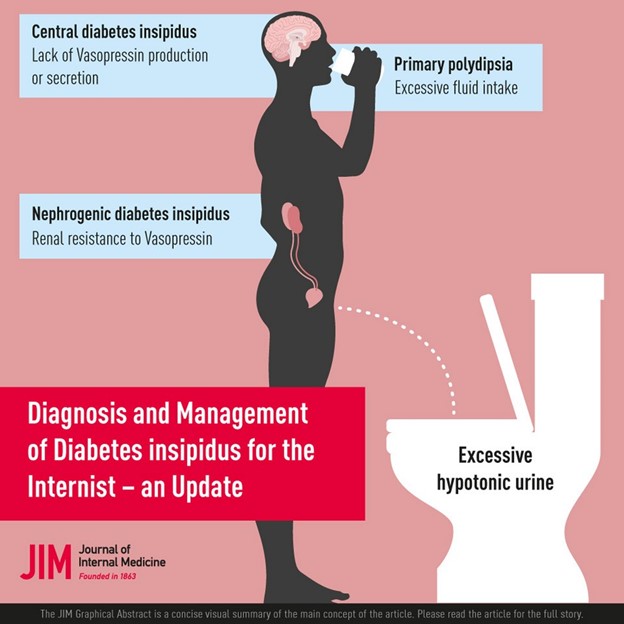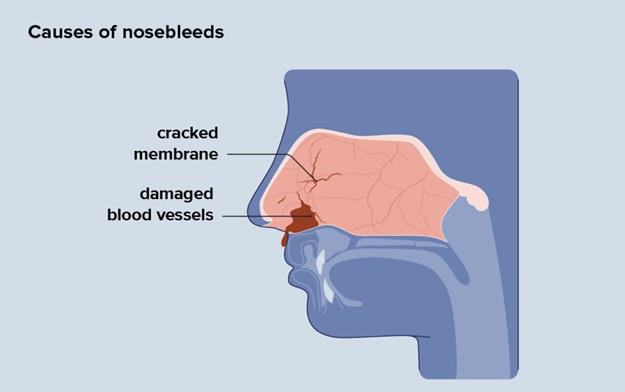The nurse is caring for a child with suspected diabetes insipidus. Which clinical manifestation would be observable?
Oliguria
Glycosuria
Nausea and vomiting
Polydipsia
The Correct Answer is D

Diabetes insipidus is a disorder of the posterior pituitary gland that causes a deficiency of antidiuretic hormone (ADH). This leads to excessive urination (polyuria) and excessive thirst (polydipsia) as the body tries to balance the fluid loss. These symptoms may be so severe that the child does little other than drink and urinate.
Choice A is wrong because oliguria means decreased urine production and is not associated with diabetes insipidus.
Choice B is wrong because glycosuria means glucose in the urine and is associated with diabetes mellitus, not diabetes insipidus.
Choice C is wrong because nausea and vomiting are associated with inappropriate ADH secretion (SIADH), which causes fluid retention and hyponatremia, not diabetes insipidus.
Nursing Test Bank
Naxlex Comprehensive Predictor Exams
Related Questions
Correct Answer is B
Explanation
A way to establish rapport. Doing a simple magic trick using gauze is a way to gain the child’s trust and attention, and to make the dressing change less stressful and more fun. This is appropriate for a 5-year-old child who is in the stage of initiative versus guilt according to Erikson’s theory of psychosocial development.
Choice A is wrong because 5-year-old children are curious and imaginative, and they enjoy magic tricks and fantasy play.
Choice C is wrong because a simple magic trick is not too distracting, but rather a way to engage the child and reduce anxiety.
Choice D is wrong because a simple magic trick is not inappropriate due to the child’s cognitive development. According to Piaget’s theory of cognitive development, 5-year-old children are in the preoperational stage, which means they can use symbols and language to represent objects and events.
A magic trick using gauze is a symbolic representation of something else, which the child can understand and appreciate.
Correct Answer is A
Explanation
This is a normal respiratory change in pregnancy caused by elevated levels of estrogen. Estrogen increases blood flow and causes the nasal mucosa to swell, leading to congestion and nosebleeds. This condition is called pregnancy rhinitis and affects up to 20% of pregnant women.

Choice B is wrong because this is not an abnormal cardiovascular change, and the nosebleeds are not an ominous sign. They are usually harmless and do not affect the pregnancy outcome.
Choice C is wrong because there is no evidence that the woman is a victim of domestic violence.
This is a serious accusation that should not be made without proper assessment and screening.
Choice D is wrong because there is no indication that the woman has been using cocaine intranasally. Cocaine use can cause nasal damage and bleeding, but it can also have other signs and symptoms such as agitation, euphoria, dilated pupils, increased heart rate and blood pressure, and risk of miscarriage or preterm labor.
Whether you are a student looking to ace your exams or a practicing nurse seeking to enhance your expertise , our nursing education contents will empower you with the confidence and competence to make a difference in the lives of patients and become a respected leader in the healthcare field.
Visit Naxlex, invest in your future and unlock endless possibilities with our unparalleled nursing education contents today
Report Wrong Answer on the Current Question
Do you disagree with the answer? If yes, what is your expected answer? Explain.
Kindly be descriptive with the issue you are facing.
